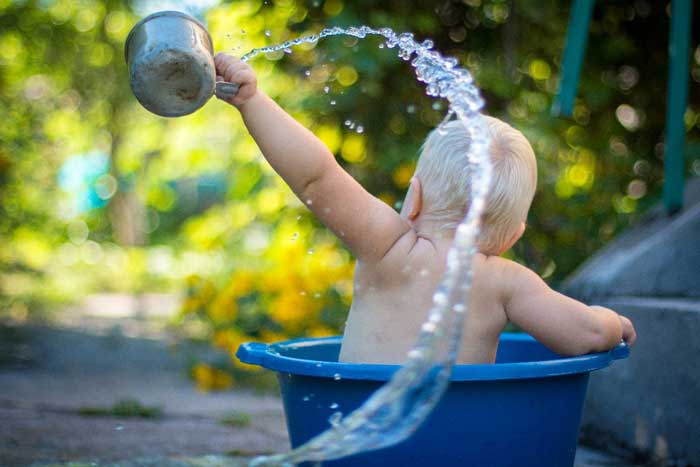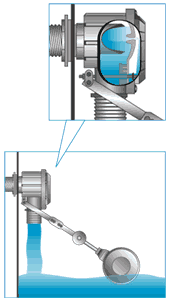How to improve water pump efficiency is a subject every homeowner with a rainwater harvesting system, farmer pumping water for livestock or agriculture and facilities manager are keen to understand more about. Our technical team has many years’ experience of advising tradespeople and end-users alike about how they can help ensure their pump lasts longer and works more efficiently. Helping to save our customers money.

After ensuring you have the right pump for the right system (essential of course), there are still many things you can do to improve your system.
Top 5 tips to improve water pump efficiency.
1. Fit a pressure vessel
A pressure vessel (also known as an expansion vessel, pressure accumulator) is an essential bit of kit for any pumped water system. It is your patient friend helping you to combat even the smallest of water leaks (say from a toilet cistern or slowly leaking outdoor pipe connection).
Even a small drop in pressure (from a single drop of water) will make your pump start. If it is starting unnecessarily hundreds of times a day, thousands of times a week, you will soon shorten the lifespan of your pump by killing the capacitor.
Pressure vessels are fitted after the pump and provide a reserve of pressurised water to the rest of the system. Inside the pressure vessel is a membrane with air on one side and water from your pump on the other. Air, as you probably know, can be compressed far more than water, so when a drop of water leaves your system the air side of the pressure vessel expands (just a little) to take up the slack. It therefore significantly reduces the number of unnecessary starts of, and wear on, the pump.
Bottom line, a pressure vessel prolongs the life of your pump by stopping unnecessary starts.
2. Fit faster valves in toilet cisterns and header tanks
 Old style brass ball cocks and other valves can take a long time to top up a header tank or toilet cistern. You can often hear the valve slowly closing as the tank is nearly full - the sound gets higher and higher. This prolongs the amount of time the pump needs to be running.
Old style brass ball cocks and other valves can take a long time to top up a header tank or toilet cistern. You can often hear the valve slowly closing as the tank is nearly full - the sound gets higher and higher. This prolongs the amount of time the pump needs to be running.
Replacing these old valves with modern QuickStop valves will shorten the pump run time. When used in conjunction with a pressure vessel (described above) you create a great energy saving system at very little cost and will improve your pump efficiency.
3. Fit an inverter
You can think of an inverter as technology that reduces the amount of electricity you need to run your pump.
A water pump inverter maintains a constant and stable pressure in a water system by varying the speed of the pump motor to deliver the same pre-set pressure at the outlet regardless of how many outlets or appliances are in use, up to the maximum capability of the pump.
So instead of your pump running at a fixed maximum speed whenever it is required, an inverter will vary that speed so the pump only uses as much energy as required whenever it is required. Helping to save you money.
4. Fit a pump dry-run protection system
Water cooled pumps are designed to work with the water either acting as a coolant. Trying to pump water when there is no water available to pump will damage a pump that doesn’t have built-in dry run protection. The pump will overheat, the motor may fail, and the bearing and shaft seals will also be damaged.
Fitting a dry-run protection system can be something as simple as fitting a float switch to your pump and installing the switch within your water tank. The float switch, with its cable adjusted to a suitable height, stops your pump from pumping when water levels get too low (and enables the pump to run when water levels ok again).
When should a pump with built-in dry run protection also be fitted with a float switch?
 Even if your pump is fitted with dry-run protection it can be a good idea to fit a float switch for extra protection. Some submersible pumps are not designed to run out of water at all – they are externally water cooled so need to be in water all the time while they are running. Fitting a float switch on these pumps adds extra protection by ensuring that the water never gets so low that the pump is partially out of water.
Even if your pump is fitted with dry-run protection it can be a good idea to fit a float switch for extra protection. Some submersible pumps are not designed to run out of water at all – they are externally water cooled so need to be in water all the time while they are running. Fitting a float switch on these pumps adds extra protection by ensuring that the water never gets so low that the pump is partially out of water.
5. Fit a floating intake on clean water pumps
If you are pumping water from a system collecting rainwater it is a good idea to fit a floating intake to your pump inlet. A floating intake has a small filter fitted underneath a floating ball and is connected to your pump inlet via a length of hose.
Even if you have already fitted a filter on the downpipe from your roof, there will still be some small debris flowing through into your water tank. Oils and pollen will float at the top of your water tank, leave debris and fine particles heavier than water will sink to the bottom of your tank. Therefore, the cleanest water in your tank is in between.
If debris is pumped through a clean water pump it could damage the impellers and, worst case scenario, block the pump entirely causing the pump to overheat and fail.
A floating intake sits about 25cm below the surface level of the water and ensures the cleanest water is pumped. This means that your clean water pump is pumping clean water and no bits of debris will be sucked through the pump potentially blocking the flow.
Further information
Further information about all the products mentioned can be found on the relevant product page on this site. If, however, you would like advice about your system and now to improve the efficiency of your water pump and save money, please contact us. Our helpful team of technical engineers are always happy to help.

